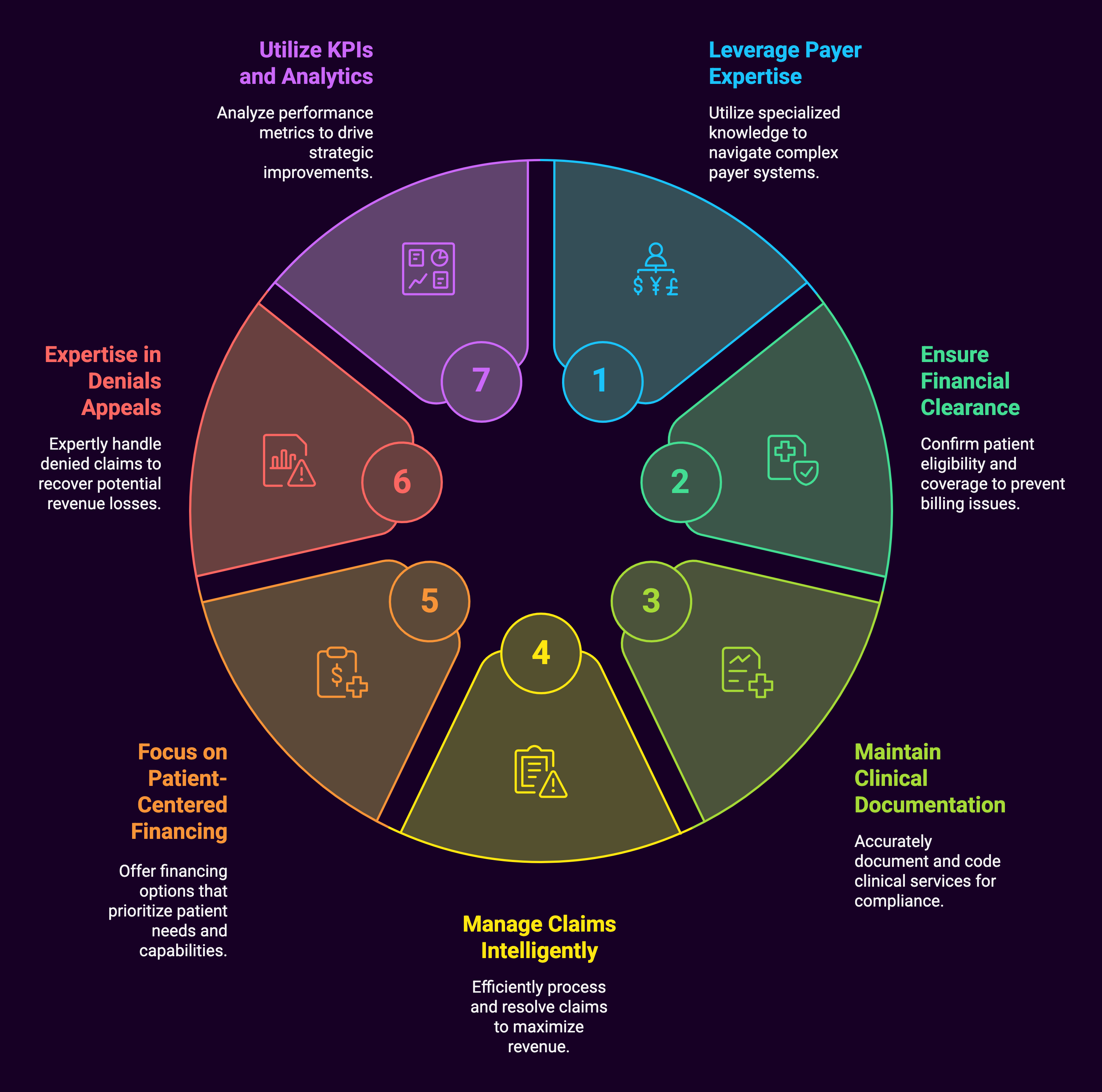Medical billing sits at the heart of provider revenue cycles, yet few fully appreciate the complexities billing teams navigate to keep financial flows stable. Between interpreting endless payer policies, wrestling with outdated technology, and managing behind-the-scenes patient communications, it takes specialized skills to turn charges into reimbursements.
It serves as the financial backbone of the healthcare system, translating the diverse array of provided services into a standardized language of codes. This vital process involves assigning Common Procedural Terminology (CPT) codes to medical procedures, ensuring accurate and transparent reimbursement from insurance entities.

Beyond its financial implications, medical billing plays a crucial role in healthcare efficiency, allowing providers to focus on delivering quality care while negotiating the intricate landscape of billing intricacies. Ultimately, it’s the linchpin that connects healthcare service delivery with the financial ecosystem, contributing to the sustainability and accessibility of healthcare services.
Unfortunately, many organizations still rely on legacy approaches that fail to address the nuances now required for billing excellence. But those pioneering optimized processes and automation are realizing improved speed, accuracy, and yields driving the financial growth necessary for advancing quality of care.
Below, we’ll reveal the secret sauce, the essential ingredients for billing to thrive in today’s digital-first healthcare ecosystem.
Medical Billing Secret Sauce Ingredients

Ingredient #1: Specialized Payer Expertise and Insights
Billing teams spend excessive hours interpreting vague explanation of benefits (EOBs), researching changing payer guidelines, and deciphering cryptic denial rationales. Yet limited visibility into payer inner workings hinders proactive optimization.
Best-in-class billing operations cultivate dedicated payer expertise encompassing:
- Historical claim performance analysis identifying improvement opportunities. What are the top denials by volume and dollar amounts? Which rejection reasons offer easiest prevention wins?
- Real-time rulebooks and policy databases providing guidance for cleaner first-pass claim acceptance without wasted rework. Is medical necessity documentation required for a procedure code? How do different payers handle modifier use?
- Up-to-date coverage details for hundreds of plans to validate everything from referral and precertification requirements to usual and customary rate limits at the point of scheduling. Is an insurer in-network? What is the formulary status of a prescribed medication?
- Ongoing payer release monitoring and training to stay ahead of changes and prevent surprise claim rejections or underpayments after submission. How are new codes mapped? What is needed to comply with a new payment policy taking effect next month?
Arming staff with specific payer knowledge optimizes pre-submission claim scrubbing and equips them to address exceptions and denials. Integrated payer analytics and automated workflows then leverage these insights for hands-off productivity.
Ingredient #2: Watertight Patient Financial Clearance
Pinpointing patient liability early in the revenue cycle prevents unpaid claims exposure before services render. Yet convoluted insurance benefits and subpar eligibility checks handicap upfront financial clearance, prompting collections challenges down the road.
Airtight clearance requires assessing both coverage specifics and patient propensity/ability to pay upon scheduling:
- Verifying active coverage, enrolled dependents, facility/provider network status, active authorizations, and benefit limits through payer data connections for real-time certainty
- Estimating total out-of-pocket costs incorporating benefits, deductibles, and variable fees to set clear repayment obligations before sticker shock bills hit
- Quantifying patient propensity and ability to pay using predictive modeling and dynamic questionnaires to tailor affordable payment plan options proactively
- Obtaining upfront deposits for estimated patient shares to ease collection velocity and demonstrate commitment
Accurate benefits insight matched with individualized financing options converts more appointments into revenue by ensuring collectability before resources expend on no-pay encounters.
Ingredient #3: Watertight Clinical Documentation and Coding
Complete and precise clinical documentation is crucial for accurate claims coding and optimal reimbursement yields. Yet overloaded physicians often lack the time to capture comprehensive notes. Vague, conflicting and missing details then lead to incorrect code assignments undervaluing services and resulting in denials upon submission.
Optimizing documentation and coding quality at the source involves:
- Clinical language monitoring through natural language processing (NLP) to detect deficiencies in terminology supporting accurate code selection
- Concurrent physician querying to rectify vagueness immediately while details remain fresh
- Computer-assisted coding (CAC) applying algorithms to identify all billable diagnosis details validated within notes
- Automated auditing against payers’ medical necessity criteria before coding to prevent downstream issues
Clean documentation ensures proper code sequencing and specificity (like differentiating between strain vs sprain or sepsis vs severe sepsis). This maximizes reimbursement under ICD-10 while also upholding compliance.
Ingredient #4: Intelligent Claims Management
The average practice loses up to 10% of collections to avoidable first-pass claim denials averaging a 14-day rework cycle to rectify.
Automating submissions introduces checks and balances for smarter claims management:
- Rules-based pre-screening against historical denials data and payer requirements helps claims pass at higher rates before reaching payers
- Real-time claim grading highlights errors for correction prior to submission, improving first-time acceptance
- Payer policy integration provides guidance to remedy issues through evidence-based edits for common deficiencies
- Automated utilization review ensures documentation supports medical necessity and adherence to billing best practices
- Split-claim automation maximizes payment on approved services when bulk submissions contain a mix of covered and non-covered charges
Streamlining claims preparation, entry and tracking drives cash flow via fast acceptance while also reducing labor-intensive re-work that drains productivity.
Ingredient #5: Patient-Centered Financing
Limited payment options and decentralized billing processes frustrate patients and suppress collections.
Consumer-focused financing that accounts for individual circumstances improves yield:
- Customized payment plan terms based on personalized affordability (like income, FSA/HSA balances, etc.) encourage mutually beneficial resolutions
- Online calculators and estimators set clear repayment expectations upfront while allowing self-service budgeting
- Digital-first engagement matching patient communication preferences improves convenience and transparency
- Clear upfront plan selection and integrated repayment reconciliations prevent surprise bills from fragmented statements
- Automated delinquency and balance chasing nurtures accounts through active resolution across multiple bills
Meeting patients where they are financially breeds loyalty while acceleration collections velocity.
Ingredient #6: Specialized Denials Appeal Expertise
Despite best efforts, some claims denials remain inevitable, especially as payers tighten policies. Yet, only a fraction of initial rejections get pursued for appeal despite potential for additional recovery. Win rates for contested denials average 56%, yet without staff expertise, the costs of manual appeal filing often discourage providers from recouping rightful reimbursements.
Data-driven and automated approaches make appealing worth the effort:
- Denial analytics uncover the most prevalent rejection causes and where introduction of additional documentation proves successful
- Rules-based algorithms instantly identify denials with high probability of favorable appeal outcomes
- Automated filing prepares necessary claim details, medical records and appeal letters for submission to payers
- Denial databases track appeal statuses through the adjudication lifecycle for easy monitoring
Specializing in revenue recovery through data-driven denial management expertise maximizes yielded reimbursement.
Ingredient #7: Insight-Driven KPIs and Analytics
Blind spots into overall billing efficiency plague operations relying on spreadsheets and manual reporting.
Dynamic analytics illuminate performance gaps to enhance outcomes:
- Key performance indicators (KPIs) like net collections, aging buckets, and first-pass claim rates pinpoint issues areas negatively impacting revenue
- Revenue cycle analytics models quantify the financial impact of operational deficiencies to demonstrate ROI in addressing
- Automated quality assurance audits ensure both clinical and billing documentation integrity to minimize compliance risks
- Reporting dashboards visualize trends over time after interventions to track and sustain continuous improvements
Data-driven insights inform targeted efforts toward optimized, accountable billing operations.
Summary: Ingredients for Optimized Medical Billing Outcomes
Like a secret recipe, the ingredients blended properly prepare medical billing to satisfy both financial and patient experience appetites. Healthcare leaders must move beyond status quo practices and tools by embracing automation, analytics and personalization demonstrated to transform outcomes. With the right recipe, high-performing billing operations become a revenue-driving competitive edge.

